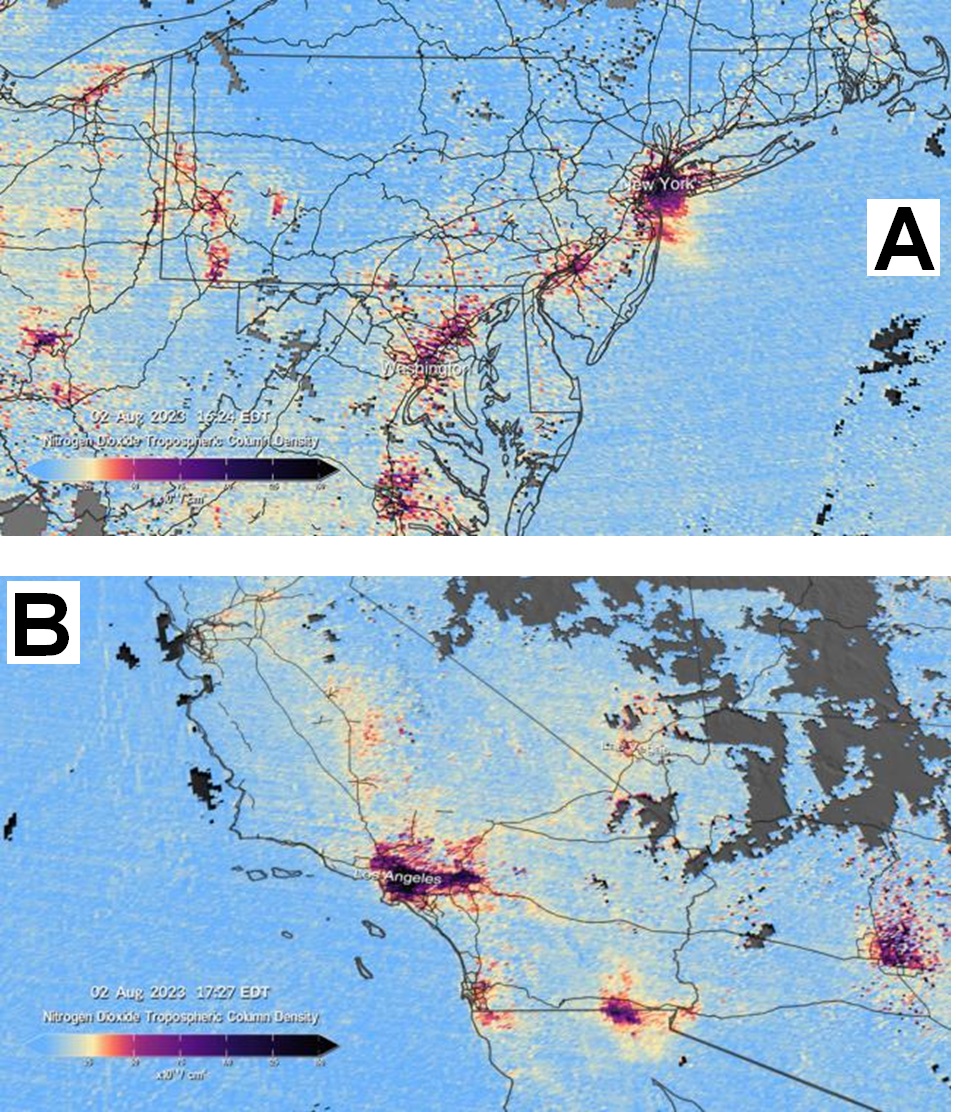
24 Aug 2023
TEMPO is the first space-based probe to measure air pollution hourly over North America at neighborhood scale.
The first images, collected once per hour over a six-hour time window Aug. 2, give a preview of TEMPO's ability to track nitrogen dioxide on an hourly basis in geographic areas as small as four square miles, or about the size of the National Mall in Washington, D.C. Nitrogen dioxide is a toxic pollutant involved in the formation of ground-level ozone and particle pollution, and it is primarily released from burning fuel.
"Our first look at TEMPO's data shows that it is working superbly," said Xiong Liu, the deputy principal investigator of the TEMPO mission, a senior physicist from SAO and a member of the Center for Astrophysics | Harvard & Smithsonian (CfA) in Cambridge, Massachusetts. "This is a very exciting moment for our team after working on TEMPO for over a decade. We can now proudly say we're beginning a new era of air-quality monitoring over North America."
Scientists at SAO conceived the concept of TEMPO and developed ground systems hardware and software, including the Instrument Operation Center and Science Data Processing Center, located at CfA, responsible for commanding the instrument and receiving and processing its raw science data. After initial processing, the data will be posted to NASA's Atmospheric Science Data Center in Hampton, Virginia, and made available to scientists and the public.
In addition to nitrogen dioxide, TEMPO will track most major air pollutants during daylight hours, including ozone, aerosols, sulfur dioxide and formaldehyde, from sources such as cars, oil refineries and wildfires. At night, TEMPO will also measure light pollution, unwanted or excessive light that can damage the environment.
Operating approximately 22,000 miles (35,790 kilometers) above North America, TEMPO will examine a large region that is home to a diverse array of communities, species and environments.
Until now, most Earth-monitoring satellites operated at lower altitudes, collecting data over a particular region once per day. TEMPO’s ability to monitor nearly the entire North American continent throughout daylight hours is a significant improvement. This gives scientists the ability to study how air quality changes over the course of a day, and how it differs between regions and even neighborhoods. With this information, scientists using TEMPO can analyze how air pollution disproportionately impacts underserved communities and how these inequities can be resolved with informed policy.
"If this summer's wildfires in Canada are any indication, it’s clear that pollution emitted in one place can impact communities thousands of miles away, especially communities that are more susceptible to the negative effects of poor air quality," said Raid M. Suleiman, an astrophysicist at SAO and CfA.
The TEMPO data could lead to more effective air-quality warnings, which may help individuals with preexisting respiratory conditions know when to stay inside. It can also uncover how changing weather patterns caused by climate change are impacting air quality and contributing to the health of wildlife and vegetation.
"TEMPO has the potential to revolutionize forecasts of air quality in North America," said Caroline Nowlan, a physicist at SAO and CfA. "It will also serve as the North American component of an international constellation of satellites for air-quality monitoring."
In 2012, TEMPO was selected as NASA's first Earth Venture Instrument. TEMPO was built by Ball Aerospace, and the instrument is attached to Intelsat IS-40e, a telecommunications satellite manufactured by Maxar and launched into space April 7. TEMPO was successfully powered on for the first time June 8 and then started its commissioning phase, which included a month of instrument testing. TEMPO then performed first-light measurements between July 31 and Aug. 2. Commissioning activities will continue until early October before starting full operations. Data from TEMPO will eventually supplement regional air-quality data from the Environmental Protection Agency (EPA), improving the agency’s ability to deliver high-quality air-quality data to the public, including real-time pollution reports and forecasts through a website and mobile app. Scientists from SAO will send some commands to the instrument in real time, allowing TEMPO to monitor sudden environmental events such as wildfires or volcanic eruptions.
"TEMPO will give us crucial data that we need to help us build a more sustainable planet for all living things," said Lisa Kewley, director of SAO and CfA. "We're thrilled to see the first data from this fundamentally important mission."
[Image]
(A) This visualization shows nitrogen dioxide over the D.C./Philadelphia/New York City region.
(B) This visualization shows nitrogen dioxide over Southern California.
